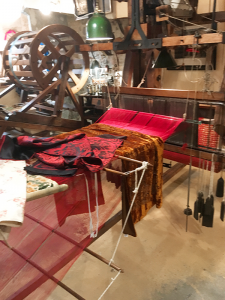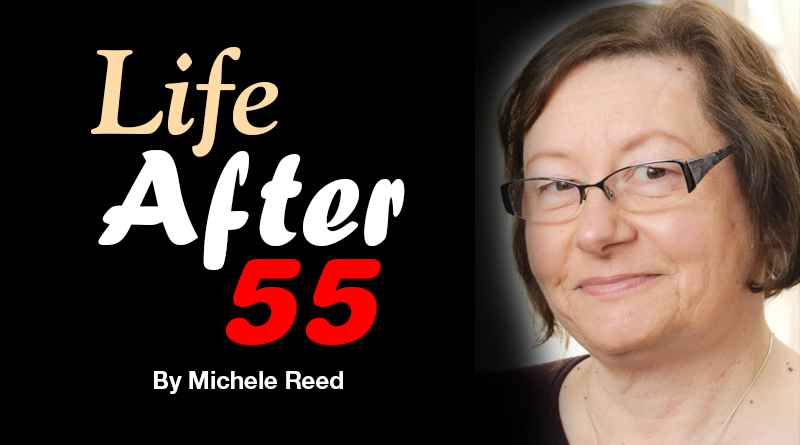All in the Family: Seven Generations of Silk Artisans
By Michele Reed
michele@cny55.com
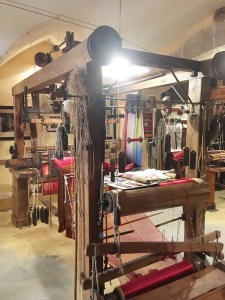
One of our goals in moving to France was to establish a base from which we could explore the region. This fall, we were able to begin making good on that goal with a petite aventure, or little adventure, to the city of Lyon.
Our Cartes de Senior, or senior citizens discount cards, give us discounts for train travel inside France. So when railway company SNCF offered us drastically reduced fares to Lyon, France’s second largest metropolitan area, we couldn’t say no. The city is known for its history, shopping, gastronomic delights and centuries-old silk industry. Only a two-hour train journey from our home, an adventure to Lyon was irresistible.
We alighted from the train at 10 a.m. and set out to explore the way we do best: on foot. Our hotel was on the Presque Isle between the city’s two rivers, the Saone and the Rhone. We crossed the Saone by a red pedestrian bridge and headed for Vieux Lyon or the Old Town, entering the St. George Quarter.
The cobblestones in Vieux Lyon were brutal. After five years of part-time living in France, we’re used to cobblestones, but these seemed like boulders. So I was grousing about sore feet when Bill said, “Look at the scarves in that shop!” A quaint-looking shop window proclaimed “Soierie Saint-Georges” or the St. George Silk Workshop. Beautifully colored scarves and shawls in a rainbow of hues beckoned.
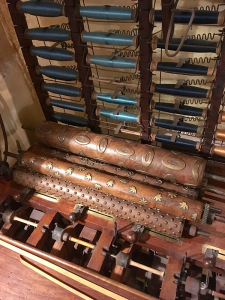
I stepped in and fingered the wares. There were shiny iridescent silk squares, wool and silk scarves, and silk and cashmere jacquard shawls, ranging in price from 20 to 150 euros. The labels read, “Made in France” or “Made in Lyon.” I went from one rack to another, feeling the different weights and textures, delighting in the way the light played off the colors. Atop the counter, a weathered carved oak desk, a rack of sheer chiffon oblongs called to us. One in particular, a beige and brown array of art deco roses, caught Bill’s eye and he offered it as a gift. I asked the proprietor where it was made. “Right here,” he answered. “In Lyon?” “Oui, madame, in my family’s workshop.”
Romain De la Calle gestured to where an ancient machine stood with three dozen bobbins of silver and gold metallic threads arrayed in a circle. We could see a length of shiny ribbon emerging from the other end. “May we?” He nodded, and Bill and I took turns cranking the worn oak handle of the tresseuse from 1850. We soon got the hang of providing the steady motion that created a smooth braid.
Romain led us to a back room saying, “Our atelier. Look around.”
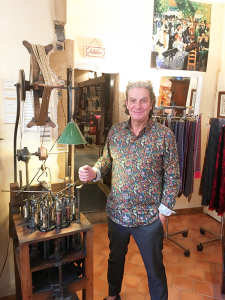
We stepped through the archway into another century. There were looms 200 years old or more. Boxes of bobbins with silk thread in a rainbow of colors. Raw silk ready for spinning, that felt like finely spun spider webs formed into a ball. Under a photo of inventor J. M. Jacquard, stood the semi-automatic loom for making the richly patterned fabric that bears his name, a length of fabric in progress. Invented in 1804, the systeme jacquard has 8,000 threads and it takes three weeks to put them all on the loom. A book of jacquard patterns leaned against a box with punch cards to program the machine — the precursor of early computers? Mannequins were draped with lengths of finished fabrics in all colors.
We were like kids in wonderland. The beauty of the silks and the aura of history surrounding the process were breathtaking. We spoke at length with Romain’s father, Ludovic De la Calle. He told us that the history of silk making in Lyon dates to the 16th century, when two Italian artisans, Nariz and Turquet, emigrated to the city.
In 1536, King Francois first issued a royal decree making Lyon the only licensed silk center in France. The trade grew to the point where a 1788 census showed Lyon had 14,777 silk looms in 5,832 workshops, according to the atelier’s brochure.
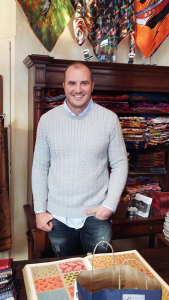
The French Revolution in the 18th century and labor revolts by the canuts, or silk workers, in the 19th would seriously disrupt the industry, but silk is still important to the city’s economic life.
The De la Calle workshop dates to 1820, the last in the Old Town, and Ludovic took it over 20 years ago so that it did not disappear. The silk trade spans seven generations of the family, each generation passing on the skills to the next. Before the workshop, the De la Calles had another weaving factory in another neighborhood where five generations of weavers practiced their art. The women spun the threads from raw silk and the men worked the looms. Ludovic learned at his father’s side and Romain started “when he was this big!” said Ludovic, placing his hand at knee height.
At the peak of the silk trade in the 18th century, there were 30,000 tisseurs or silk weavers in the city, Ludovic told us. Now there are 10, including the De la Calle family. Only three workshops exist, including theirs.
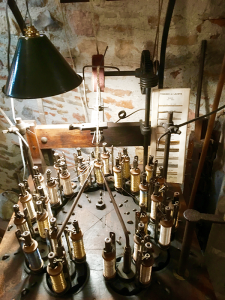
The family makes silks for famous couturiers and design houses, but just who those designers are must remain confidential. Ludovic could tell us that the family produces fabrics for the historic monuments of France, reproducing originals for the Chateau de Versailles, Louis XIV’s famous palace, as well as Fontainebleau Palace and other important French heritage sites.
The art of silk-working is also part of that rich heritage — called patrimoine in French.
“It is an affaire familale,” Ludovic told us with pride — a family affair. “It is very, very important that we transmit the knowledge for the generations to come.”
We stepped back out onto the cobblestones of Lyon’s Old Town, clutching my new scarf, but also carrying a newfound appreciation for an ancient art and the family of artisans who keep it alive.
